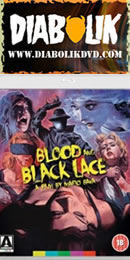

Color, 1964, 88m.
Directed by Mario Bava
Starring Cameron Mitchell,Eva Bartok, Thomas Reiner, Ariana Gorini, Mary Arden, Franco Ressel, FrancescaUngaro, Claude Dantes, Harriet White, Lea Lander
Arrow (Blu-ray & DVD) (UK RA/B HD/NTSC) / WS (1.66:1) (16:9), e-m-s (DVD) (Germany R2 PAL), VCI (DVD) (US R1 NTSC) / WS (1.78:1) (16:9)
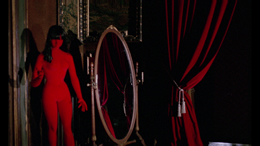
 Blood and Black Lace was really the first film to merge the world of modeling with ritualistic murders, and none of its imitators have managed to capture the same level of intensity. Originally released as Sei donne per l'assassino (or Six Women for the Murderer), the film was directed by Mario Bava at the height of his directorial powers (coming hot off of Black Sabbath and The Whip and the Body and just before Planet of the Vampires), but its unprecedented aesthetic brutality encountered censorship problems around the world.
Blood and Black Lace was really the first film to merge the world of modeling with ritualistic murders, and none of its imitators have managed to capture the same level of intensity. Originally released as Sei donne per l'assassino (or Six Women for the Murderer), the film was directed by Mario Bava at the height of his directorial powers (coming hot off of Black Sabbath and The Whip and the Body and just before Planet of the Vampires), but its unprecedented aesthetic brutality encountered censorship problems around the world. 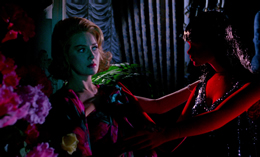 imitated with panache in I Know What You Did Last Summer), illuminated by the director's signature gel lighting and accompanied by Carlo Rustichelli's terrific bossa-tinged score. While most of the performers are simply fodder for their inevitable turn with the killer, Bartok and Mitchell manage to turn in intriguing performances, alternately vulnerable and suspicious, while the women look appropriately lovely in their designer label perfection.
imitated with panache in I Know What You Did Last Summer), illuminated by the director's signature gel lighting and accompanied by Carlo Rustichelli's terrific bossa-tinged score. While most of the performers are simply fodder for their inevitable turn with the killer, Bartok and Mitchell manage to turn in intriguing performances, alternately vulnerable and suspicious, while the women look appropriately lovely in their designer label perfection. 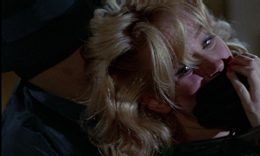
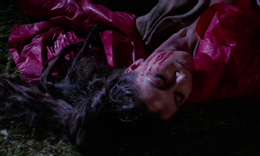 The DVD also includes the original U.S. trailer, as well as virtually identical French and Italian trailers, bonus trailers for Erik the Conqueror and the French trailer for The Whip and the Body, as well as a video interview of Cameron Mitchell by David Del Valle (carried over from the Roan disc) and a video interview with Mary Arden, one of the victims and a screenwriter in her own right. The factual information in the Mitchell interview is highly questionable; Mitchell claims to have made six films for Mario Bava and refers to his filmmaking son as"Umberto" instead of Lamberto. Other goodies include a gallery of photos and promotional art, an isolated soundtrack presentation of four tracks from the original rare Italian vinyl release (later rendered obsolete by Digitmovies' gorgeous release of the full stereo soundtrack on CD), and the alternate American credits.
The DVD also includes the original U.S. trailer, as well as virtually identical French and Italian trailers, bonus trailers for Erik the Conqueror and the French trailer for The Whip and the Body, as well as a video interview of Cameron Mitchell by David Del Valle (carried over from the Roan disc) and a video interview with Mary Arden, one of the victims and a screenwriter in her own right. The factual information in the Mitchell interview is highly questionable; Mitchell claims to have made six films for Mario Bava and refers to his filmmaking son as"Umberto" instead of Lamberto. Other goodies include a gallery of photos and promotional art, an isolated soundtrack presentation of four tracks from the original rare Italian vinyl release (later rendered obsolete by Digitmovies' gorgeous release of the full stereo soundtrack on CD), and the alternate American credits.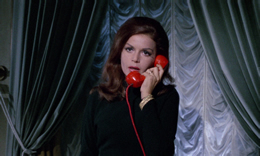
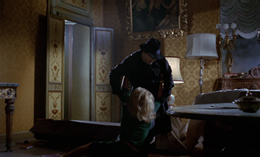 known to pop up from time to time at screenings around Hollywood, too. Otherwise it's all new supplements here, with Tim Lucas leading the pack with a brand new, significantly updated years after his book to provide a denser reading of the film as well as a
known to pop up from time to time at screenings around Hollywood, too. Otherwise it's all new supplements here, with Tim Lucas leading the pack with a brand new, significantly updated years after his book to provide a denser reading of the film as well as a  wealth of facts uncovered since his previous track fifteen years ago. Once again he does an admirable tightrope act walking between technical facts and critical analysis while explaining how the film has now firmly cemented itself not only as the first bona fide color giallo but a major title in world cinema, period.
wealth of facts uncovered since his previous track fifteen years ago. Once again he does an admirable tightrope act walking between technical facts and critical analysis while explaining how the film has now firmly cemented itself not only as the first bona fide color giallo but a major title in world cinema, period.